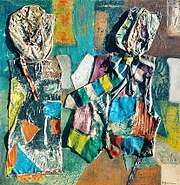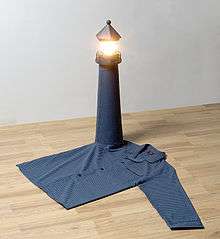Mixed media
In visual art, mixed media is an artwork in which more than one medium or material has been employed.[1][2] Assemblages and collages are two common examples of art using different media that will make use of different materials including cloth, paper, wood and found objects.


Mixed media art, a visual art, is distinguished from multimedia art which combines visual art with non-visual elements, such as recorded sound, literature, drama, dance, motion graphics, music, or interactivity.[3][4]
History of mixed media
The first modern artwork to be considered mixed media is Pablo Picasso's 1912 collage Still Life with Chair Caning, which used paper, cloth, paint and rope causing a pseudo-3D effect. Due to the influence of movements like Cubism and Dada, mixed-media grew in popularity throughout the 20th century with artists like Henri Matisse, Joseph Cornell, Jean Dubuffet, and Ellsworth Kelly adopting it. This led to further innovations like installations in the late 20th century.[5] Mixed media continues to be a popular form for artists, with different forms like wet media and markings being explored.[6]
Types of mixed-media art
Mixed media art can be differentiated into distinct types,[7] some of which are:
Collage: This is an art form which involves combining different materials like ribbons, newspaper clippings, photographs etc. to create a new whole. While it was a sporadic practice in antiquity, it became a fundamental part of modern art in the early 20th century, due to the efforts of Braque and Picasso.[8]
Assemblage: This is a 3-dimensional variant of the collage with elements jutting in or out of a defined substrate, or an entirely 3-D arrangements of objects and/or sculptures.[9]
Found object art: These are objects that are found and used by artists and incorporated into artworks because of their perceived artistic value. It was popularized by the conceptual artist Marcel Duchamp.[10]
Altered books: This is a specific form where the artist will reuse a book by modifying/altering it physically for use in the work. This can involve physically cutting and pasting pages to change the contents of the book or using the materials of the book as contents for an art piece.[7]
Examples of mixed-media artwork
Still Life with Chair Caning: Picasso's piece depicts what can be seen as a table with a cut lemon, a knife, a napkin and a newspaper among other discernible objects. It is elliptical (with speculation that the work itself could be depicting a porthole) and has actual rope used for forming its edge. Paper and cloth are used for the objects present on the table.[11]
Angel of Anarchy: Eileen Agar's 1937 sculpture is a modified bust of Joseph Bard, which was covered by paper and fur. When this was lost, she made a 1940 variation which shrouded and blinded the figure with feathers, beads and cloth creating an entirely different perspective on the sculpture.[12]
See also
References
- William Vaughan (2000). Encyclopedia of Artists: Art movements, glossary, and index. Oxford University Press. ISBN 978-0-19-521572-4.
- Tate. "Mixed media – Art Term". Tate.
- Jonathan Rosenoer (6 December 2012). CyberLaw: The Law of the Internet. Springer Science & Business Media. pp. 45–. ISBN 978-1-4612-4064-8.
- "Mixed Media As A Quintessential Contemporary Art". www.irishmuseumofmodernart.com.
- "History of Mixed Media Art and How Mixed-Media Differs From MultiMedia". BertaArt Studio. 2013-11-03. Retrieved 2019-10-15.
- Seth (2017-11-12). "Top Ten Trends in Mixed Media Art in 2017". The Altered Page. Retrieved 2019-10-31.
- Liphart, Jill. "Mixed Media Techniques: Art for All Ages". Udemy Blog. Retrieved 2019-10-31.
- "Greenberg: Collage". www.sharecom.ca. Retrieved 2019-10-31.
- Tate. "Assemblage – Art Term". Tate. Retrieved 2019-10-31.
- Tate. "Found object – Art Term". Tate. Retrieved 2019-10-31.
- Hopkins, Budd. "Modernism and the collage aesthetic." New England Review 18.2 (1997): 5.
- Windsor, Alan. British sculptors of the twentieth century. Routledge, 2017.